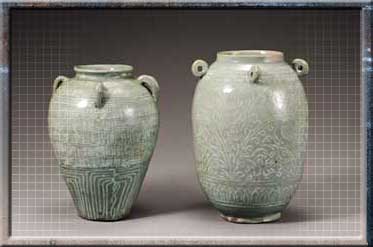
![]()

During the early Choson period, in the 15th and l6th centuries,punch'ong
ware and porcelain comprised the mainstream ceramic production.Pungch'ong-sagi
is a term coined by Ko Yu-sop(1905-44), the first Korean art historian,
and refers to a particular type of ceramic ware decorated with awhite
slip coating under the glaze. Punch'ong ware can be classified into
seven different categories according to the method of surface decoration.
They include inlaid, stamped,incised, carved, iron-painted, and brushed
white slip as well as white-coated wares. Unlike Choson porcelain, punch'ong
was produced over a limited period, namely between the end of the Koryo
dynasty to the mid- I 6th century.
As a result of the political upheavals toward the end of the Koryo dynasty,
the Koryo celadon kilns concentrated in the Cholla province were destroyed
and the potters were forced to disperse. These potters then continuedto
produce wares based on the celadon tradition, which gradually transformed
into a new ceramic ware. Excavations of old kiln sites have located
about 220 punch'ong kilns throughout South Korea. Two of the most representative
punch'ong kiln sites are the Ch'unghyo-dong kiln site in Kwangju, South
Cholla province and the Kyeryongsan kiln site in Kongju, South Ch'ungch'ong
province.
Early punch'ong ware continues the Koryo celadon tradition in itssurface
decoration. Some of the most frequently applied motifs include lotus,
chrysanthemum, and arabesque patterns.
Punch'ong ware matured stylistically during the reign of King Sejong
(r.141850). This was a period of overall cultural and social development,
which naturally had an effect on the production of ceramics. hi 1421,
the court ordered potters to inscribe their names on punch'ong wares,
and between 1424 and 1432, investigations of kilns were carried out
as a part of the publication of Chiriji, a geographical section within
the Annals of Sejong. The majority ofpunch'ong types produced during
this period comprised the inlaid and stamped punch'ong, as well as punch'ong
with the design incised or cut through white slip.